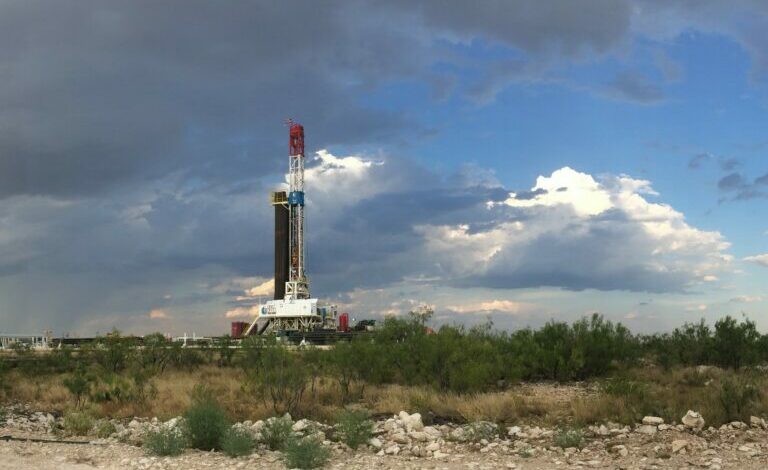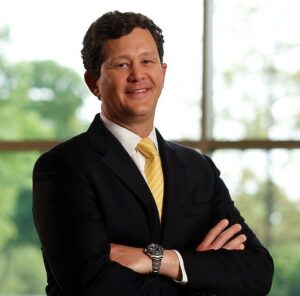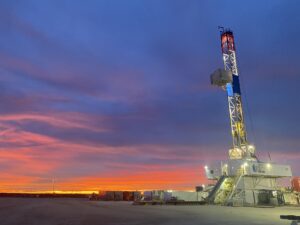Recruitment, growth mindset critical to ensuring long-term success for drilling contractors


Unit Drilling’s Chris Menefee: To hire and retain the right talent, industry will have to understand and adapt to the new generation, as well as embrace new challenges, continuous improvement
By Stephen Whitfield, Associate Editor
Chris Menefee is President of Unit Drilling.
What are the biggest challenges that you face as a drilling contractor in the current market?
Today, the No. 1 challenge is recruiting the right people, and it’s more than just entry-level positions. We face variables today that we didn’t have before.
Historically, the oilfield has been known to provide development, longevity and a career, not just a job. Over the last five years, however, many experienced people were laid off, and this time they are not coming back. Today when you listen to the news, there are an awful lot of negativities around the sustainability of the oilfield.
As an 18- or 19-year-old looking for your first job, that uncertainty causes hesitation. Many people don’t understand the lifecycle of oil and gas or how it plays into the carbon emission, greenhouse gas conversation. Many also wonder if oil and gas drilling will be a sustainable and viable industry throughout an entire career, or whether their time would be better spent doing something else.
What do you say to the young people looking to get into the industry?
We see a demand for oil and gas for many years to come, as well as the need for drilling services. We think it’s a very sustainable business. Of course, the industry is going to change. In the next 10 to 30 years, it could look very different, but there’s still going to be demand for oil and gas products for a number of years. It’s still a great business to learn something new, and it’s a great place to be part of a team.
There’s a reason Unit Drilling has been around almost 60 years. There’s a lot of pride in our company. There’s a lot of pride in our industry and what we do. There’s a lot of camaraderie. We work hand in hand among other drilling contractors, and we help each other out when we need to. We all want to succeed, provide for our families, and ensure the safety of our people and the environment. There’s not a better business to be in, from a teamwork and satisfaction standpoint.
Work is a place you call home away from home, your second family, your oilfield family. It’s challenging, and it’s not for everybody, but it’s still a great business and place to learn and develop.
Moreover, it’s a place where, regardless of your pedigree, if you work hard, you can start at the rig level and work your way up as high as you want. Not many industries provide opportunities for advancement like oil and gas if you are willing to work hard and earn your stripes.
At the IADC Annual General Meeting in November, you talked about the growth mindset. What does such a mindset encompass?
Having a growth mindset versus a closed mindset is a psychological concept, rather than a business framework, such as acquisitions or organic growth. Most of us will agree that things can change quickly in this business. We are confident in the demand for our rigs and services, but it’s going to look different. Companies will look different, business frameworks and contracts will change, and people will come and go. Most likely there will be further consolidation in our business as it’s still a very fragmented market. As change takes place, we must embrace it, learn and move on, or get left behind.
A growth mindset is important to further our industry using the lessons learned and the many challenges we have faced. As we continue to evolve, we’ve got to try new things. We’re not going to get it right the first time every time, but we must take what failures or mistakes we make, continue to improve upon them and get better. Our industry, since inception, has been a perfect example of grit, determination, perseverance and working for a common cause. We look at our lessons learned, and we figure out how we can do it better. That’s how you become excellent.
At Unit, we strive for excellence by asking ourselves, how can we make things better? We may have completed an operation well, but we’re still going to look back and determine how we can do it better the next time. This means we must work together, whether it’s contractors with contractors, or contractors with customers, or just people within each organization. That’s how we’re going ensure the sustainability of our industry, by continuously growing and continuously improving.
To be relevant long term, we’re going to have to adjust. We’re going to have to listen to our customers and to regulators, and understand what each of their needs are, so that we can continue to get better and provide good service, not just to our customers but to the entire ecosystem.

It sounds like you’re talking as much about flexibility as you are about growth?
When I think about flexibility, I think about working with our customers, to help them meet and exceed their goals. Communication plays a big part in this relationship, as well as managing expectations. Much of what we do depends on the relationship at the rig site. Every day we face unscheduled events. Therefore, we must work with our customers to understand their concerns and explain how we can get the job done safely.
We’ve seen a tremendous increase in focus on ESG over the past couple of years. How do you see this transition to a low-carbon future affecting your business in the next year and beyond?
Foremost, protection of the environment is something very important to all of us as human beings. That’s nothing new. We all want to take care of the environment and the communities in which we work. As an industry, we must work together to identify opportunities to further reduce emissions. Technologies exist today that enable drilling equipment to run on highline power, for example. We have multiple rigs contracted that will utilize electric grid power.
We work hard to innovate, but a lot is dependent on our customers and the constraints they are faced with, depending on the areas in which they operate. By working together, we will further utilize this and other technologies, such as battery storage capabilities.
The social element of managing our business revolves mostly around the recruitment, retention and recognition of our employees. It also has to do with being good stewards of the communities in which we work, and how we give back to those communities.
The younger generation has grown up a little bit differently than the way some of us have, and it’s important to understand these differences. Understanding our employees and the perspective in which they view and process information is important.
Also, understanding how they learn and respond to coaching will be critical to developing the young talent coming into our business. It’s a little bit different than the way we did, but that doesn’t mean it’s wrong, and we’ve got to be accepting of that. We’ve got to be able to coach and teach in a different manner than the way many of us learned. Diversity ties into it, meaning we must be accepting of different backgrounds and different ideas.
At Unit, we always encourage our new hires to speak up because they see things through a different lens than people who have been with the company for 20 years. Giving these individuals a job is just the beginning; we must include them and teach them. Someone took the time and effort to coach us who have been here. It’s our time to pass on those lessons and responsibilities to others.
Additionally, corporate governance is more important now than ever. This includes making sure corporate goals and expectations are aligned with those executing in the field. As managers in our industry, we have been entrusted with resources to create value and a return for all stakeholders. Policy and procedure must be in place to verify that what we say is what we do.
Going back to the rigs, do you think we’re at a point where the vast majority of competitive rigs in the US onshore market are fairly identical in terms of their physical specs? Are software and automation now the biggest differentiating factors for the top-tier rigs? If not, what are the biggest factors?
There are still small variances in rigs. If you look at most of the rigs that are drilling today, they’re AC powered, which is what really enables the software capabilities, although there are still a handful of SCR rigs getting the job done.
From an overall spec standpoint, there are going to be some rigs with a little more racking capacity than others. There are going to be some rigs with three pumps versus two pumps, three engines versus four engines. But, in the big picture, the rigs that are working today are all very close within some attributes, making what we do so competitive and relying on our crews to make the difference.
Software capabilities are a big thing, but it depends on our customer. Some operators aren’t as concerned about optimization software as others. I do think that, as software and big data continue to be used more, we’re going to learn more. Therefore, it’s going to push the limits on how we use data, how we utilize it to improve operational performance, and how we predict how wells are going to be drilled. I personally believe predictive analytics and optimization modeling will be a very important piece of how we maximize value going forward.
It’s just a matter of each organization determining what their approach is when it comes to software and data analytics. Many contractors have gone all in, spending a lot of money to have the latest and greatest. Today, Unit isn’t a leader in developing our own software platform. We are working with and listening to our customers to find the balance in terms of using software and data analytics. Now, we don’t have the resources to go out and do this on our own, but we’re partnering with other larger service companies to help us get there.
So how do you go about finding that balance between investing in new technologies and the need for capital discipline?
I think it has a lot to do with where you are in the lifecycle of your company. Some companies have more capability than others, and some have a slightly different vision. It’s all about creating value. If you spend a billion dollars on software that looks and sounds cool, but it’s not generating any value for the customer or adding anything to your balance sheet, then there’s no sense in doing it.
It will take time to develop and perfect the optimization software we have today. With the ups and downs we have encountered, it’s hard to stay focused on making this a long-term investment, while trying to keep rigs working. We don’t know exactly where we’re going to be in three, five or 10 years, given the market volatility and the cyclicality of our business.
Everybody’s got their own approach to this. I admire those that are doing it, but you must find the right fit for your business and, more importantly, for your customers. If they have a demand and a need, then you work with them and try to create value.
Do you foresee the US onshore market ever getting into a newbuild cycle again?
I’ve learned in my career to never say never. I remember in the early 2000s, we said we didn’t need new rigs. Clearly, the industry corrected itself and we built new rigs.
We might have overbuilt at that point, and then from 2010-2014 there was a whole other wave of newbuilds. Given where we are in the industry now, I’m not sure that we need another newbuild cycle.
I’m not saying never, but I don’t think building rigs will create value or that it’s what our industry needs today. Again, the people component, and now supply chain issues, will prevent this from happening any time soon, certainly not at the pace we saw in 2013-2014. Much of that has to do with access to capital and what we’ve been through as an industry over the last three to four years, and then topping it off with a global pandemic.
Today, it feels good to have our higher-end equipment and talented people working. When you consider the cost to build a new rig, along with the supply chain constraints, I don’t see newbuilds being an option for years.

So, if we’re not going to be in a newbuild cycle for the next couple of years at least, where are the rig innovations going to come from?
I think the equipment that’s in the market today is getting the job done. We’re continuing to push the limits of that equipment, and we’re having great success doing it.
You can look at the Permian Basin as an example of what we’re able to accomplish, just from a drilling standpoint. I remember not too long ago, the average well in the Delaware Basin was in the 30-day range. Now, we’re significantly less than that. Some of the wells that we’re drilling in the Midland Basin take fewer than 10 days. So, I think the equipment is there. We don’t necessarily need any bigger, higher horsepower, higher hookload or racking capacity. Most contractors have figured out how to upgrade rigs to meet the demands we are seeing, for example, for higher racking capacity.
Back to software and analytics, I think this will be the focus, as well as the environmental side. Focusing on highline power and making the rigs we have more efficient will help reduce carbon emissions and optimize performance.
We’ve talked about the importance of generating value. Drilling contractors have made significant efforts in the past few years to cut costs. Is there still any “fat” left to trim?
We can always get better, in any facet of what we do, whether that’s operations or financial performance. As for overhead “fat,” I think we’re pretty lean. The best of the best is working, but there’s always room for improvement.
Unit Corp, the parent company of Unit Drilling, recently announced it was divesting all E&P assets so it could invest more in its drilling business. Can you talk about what drove this decision?
We made the announcement that we are going to divest of the current E&P assets, but it’s still in the early stages. Unit was originally founded as a drilling company, and we’re going to be a drilling company going forward. As Unit went through bankruptcy and restructuring in 2020, opportunities were identified to become more efficient. We have new management and leadership on the Board. I think this decision is just an example of how opportunities will be evaluated going forward, with a laser focus on making money, generating value and maximizing utilization of current assets.
What do you think is the next frontier in managing safety on the rig?
There are some options when it comes to coaching and training where we can do better using virtual technologies. For example, maybe an employee can virtually look around the rig and learn before they ever step foot on the rig, rather than solely relying on hands-on training. It’s not limited to new-hire training either. Virtual training can be used to teach well control or mechanical and electrical training, such as overhauling engines, repairing mud pumps and top drives.
When it comes to pushing the efficiency and performance of drilling rigs today, are there still any “low-hanging fruits” left?
You know, somebody told me one day that a perfect well is one that doesn’t cost any money, is a 100% producer and incident free. We’re still not there yet. The low-hanging fruit is not as low as it used to be. We’ve gotten pretty good at what we do. We’re drilling 20,000- to 25,000-ft wells in a matter of days.
From an engineering standpoint, our customers and engineers are going to continue to push the limits on how to drill the wells more efficiently. From a rig perspective, a lot of it is tied into predictive analytics and being able to tell when equipment will go out, rather than waiting until it goes out.
We have robust, preventative maintenance programs in place, and we can change equipment out to keep it running, but I think data analytics and predictive analytics are going to continue to get better. It will allow us to better measure and optimize our performance.
What’s your view on the future of the drilling contractor’s business model? Is the dayrate model still the best available, or do we need to evolve to something new in order to create a more sustainable business?
First, it goes back to creating value. Second, it’s about working with your customers. The dayrate model is not perfect by any stretch. I do think there are ways that contractors should be better rewarded for their performance, but it comes down to what works between the two parties. The dayrate model is tried and true. It’s been around for 100 years.
If you go back to the growth mindset that we discussed earlier, we’re each going to have to learn and work together. There are several different performance-based models out there already, and there will be opportunities for contractors to capture a bigger piece of the pie than what we’re getting today.
As we move ahead, we look forward to partnering with our customers to ensure value is generated for both companies. DC




